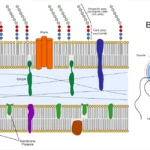IB Biology 18 Views 1 Answers
How can photosynthetic pigments be separated by chromatography?
How can photosynthetic pigments be separated by chromatography?
Answered
To separate photosynthetic pigments using chromatography, a systematic approach can be employed. Here’s a detailed experimental procedure, along with the principles behind the technique:
Overview of Chromatography
Chromatography is a method used to separate mixtures based on the differential affinities of components for a stationary phase and a mobile phase. In the context of photosynthetic pigments, this technique allows for the identification and quantification of various pigments such as chlorophyll a, chlorophyll b, carotenoids, and xanthophylls.
Materials Needed
- Plant Material: Fresh leaves (e.g., spinach, kale).
- Solvent: A mixture of solvents, commonly a 3:1:1 ratio of petroleum ether, acetone, and ethanol or hexane.
- Chromatography Paper: Filter paper or specialized chromatography paper.
- Mortar and Pestle: For grinding the plant material.
- Capillary Tubes: For spotting the pigment extract on the chromatography paper.
- Ruler: To measure distances traveled by pigments.
- Chromatography Chamber: A container to hold the solvent and paper during development.
Experimental Procedure
Step 1: Prepare Pigment Extract
- Grinding: Use a mortar and pestle to grind a small amount of fresh leaves with a few milliliters of solvent (e.g., acetone or ethanol) to extract the chlorophyll and other pigments.
- Filtration: Filter the mixture through cheesecloth or filter paper to obtain a clear pigment solution.
Step 2: Setting Up Chromatography
- Prepare Chromatography Paper:
- Cut a strip of chromatography paper about 10 cm long and mark a horizontal line approximately 2 cm from one end using a pencil (this is where you will spot the pigment).
- Spotting the Pigment:
- Using a capillary tube, spot a small amount of the pigment extract onto the pencil line. Allow it to dry before proceeding.
Step 3: Developing the Chromatogram
- Prepare Solvent:
- Pour the chosen solvent into the chromatography chamber so that it covers the bottom by about 1 cm.
- Run the Chromatography:
- Suspend the chromatography paper in the chamber so that the bottom edge is immersed in the solvent but does not touch the pigment spot.
- Cover the chamber to minimize evaporation and allow the solvent to rise up the paper by capillary action until it reaches about 1 cm from the top.
Step 4: Analyzing Results
- Remove and Dry:
- Once the solvent front has reached its desired height, remove the paper from the chamber and mark the solvent front with a pencil immediately.
- Identify Pigments:
- Measure and record how far each pigment spot has traveled from the original pencil line (the starting point).
- Calculate Rf Values:
- Calculate the retention factor (Rf) for each pigment using the formula:
Rf=Distance traveled by pigment/Distance traveled by solvent front
- Each pigment will have a unique Rf value that can be compared to known standards for identification.
- Calculate the retention factor (Rf) for each pigment using the formula:
Did this page help you?




